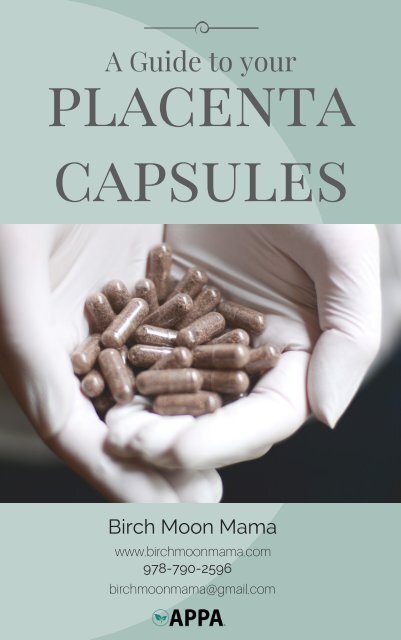Placenta Capsules
Create successful ePaper yourself
Turn your PDF publications into a flip-book with our unique Google optimized e-Paper software.
A Guide to your<br />
placenta<br />
capsules<br />
Birch Moon Mama<br />
978-790-2596<br />
www.birchmoonmama.com<br />
birchmoonmama@gmail.com
Let's Get<br />
STARTED<br />
You may begin taking<br />
your capsules right<br />
away! Typical schedule:<br />
1-2 capsules up to 3x a<br />
day. Follow your own<br />
body cues and adjust as<br />
needed. Call with<br />
questions: 978-790-2596<br />
How to adjust your dose<br />
If you feel ok, keep<br />
the dose the same<br />
If you're still feeling<br />
unbalanced; call me<br />
to discuss increasing<br />
or decreasing<br />
If it feels like too<br />
much; reduce dose<br />
slightly or spread out<br />
the timing more<br />
Signs you may want to reduce your dose<br />
You seem to have an oversupply of breastmilk<br />
You are sensitive to iron supplements or get mild<br />
head or stomache aches<br />
You feel like you have too much energy and have<br />
trouble sleeping<br />
Some women are sensitive to hormones and the<br />
nutrients in encapsulated placenta; try taking 1 less<br />
capsule and always with a meal
A few things<br />
TO KNOW<br />
Fever<br />
Mastitis<br />
Cold<br />
Mild Illness<br />
General<br />
Precautions<br />
Taper your pills to<br />
zero in one day.<br />
For example if<br />
you usually take 3<br />
pills, 3 times a day<br />
you would take 3<br />
in the morning, 2<br />
midday and 1 in<br />
the evening on<br />
the day you get<br />
sick. Then none<br />
the next day.<br />
Wait until the<br />
fever or mastitis<br />
go away and then<br />
resume your pills.<br />
You may choose<br />
to keep taking<br />
your pills and<br />
see how you fee<br />
If you don’t<br />
seem to be<br />
getting better,<br />
taper your pills<br />
to zero as<br />
described<br />
above.<br />
Wait until the<br />
illness goes<br />
away and then<br />
resume your<br />
pills.<br />
The maximum<br />
dose per 24 hours<br />
is six capsules.<br />
You should not<br />
abruptly stop<br />
taking your pills,<br />
taper down as<br />
needed.<br />
Call, text or email<br />
us with any<br />
questions or<br />
concerns regarding<br />
your capsules,<br />
tinctures or other<br />
placenta items.
STORAGE<br />
LONG TERM USE<br />
It is always my hope that mothers will use up their<br />
pills within the first six weeks of their baby’s life.<br />
This is the time when your body needs them most.<br />
Some women take a full dose for the first week<br />
or two and then slowly consume the rest as<br />
needed over the first year of their child’s life. .<br />
In the first six weeks, cupboard storage is<br />
adequate. If for some reason you don’t finish<br />
them within six weeks, store them in the<br />
freezer to maintain freshness.<br />
Do not store in a moist environments such as<br />
bathroom cabinets, fridge doors or fridges with<br />
excess condensation. The desiccant bag helps but<br />
doesn’t prevent your capsules from absorbing<br />
environmental moisture. Moisture can cause<br />
spoilage.<br />
Keep away from direct sunlight, major heat sources<br />
or any areas with frequent drastic temperature<br />
changes.
One more<br />
important note<br />
A note about long term storage: some women<br />
choose to keep their pills for use later in life (cycle<br />
returning or menopause). Unfortunately I do not<br />
have any data about the safety of long term storage<br />
of dried placenta. Since this is desiccated human<br />
tissue, not powdered minerals or dried plants like<br />
other supplements, please use extreme caution.<br />
Think of it like any other food... would you want to<br />
consume something stored for that long? There is no<br />
guarantee of potency. It is reasonable to assume<br />
that the hormones will degrade considerably over<br />
time, even in the freezer.<br />
You may also want to know....<br />
Dried placenta has a strong metallic, mineral<br />
or gamey smell; this is normal.<br />
If you look at the powder it is common to see a<br />
lot of variation in color and texture. Some parts<br />
of the placenta are pale and stringy when<br />
dried (inner fibrous structure, upper<br />
membrane), the bulk is usually reddish or<br />
yellowish brown. <strong>Placenta</strong> powder comes in all<br />
textures: floury, sandy, coarse, flaky, etc.


